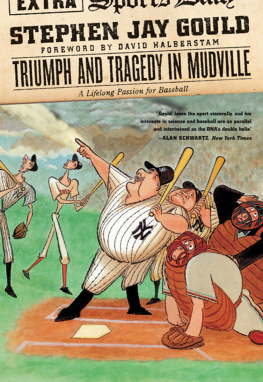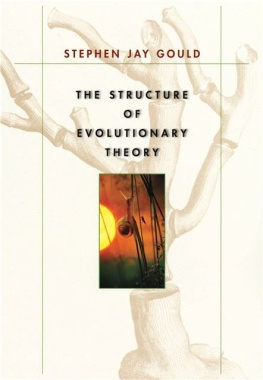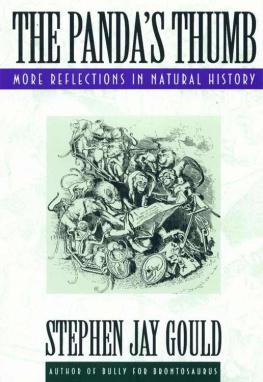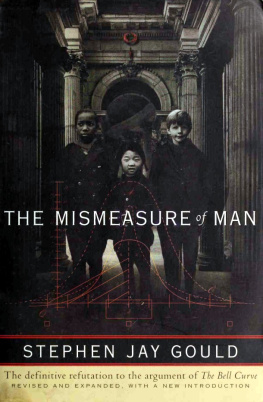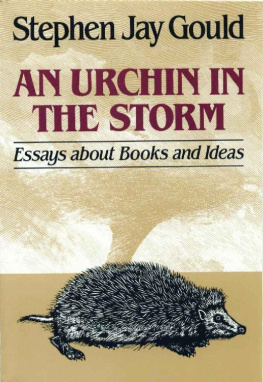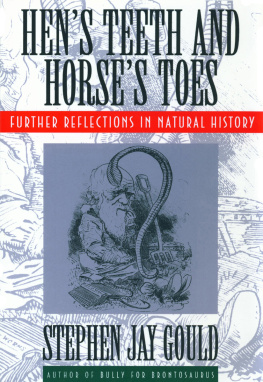
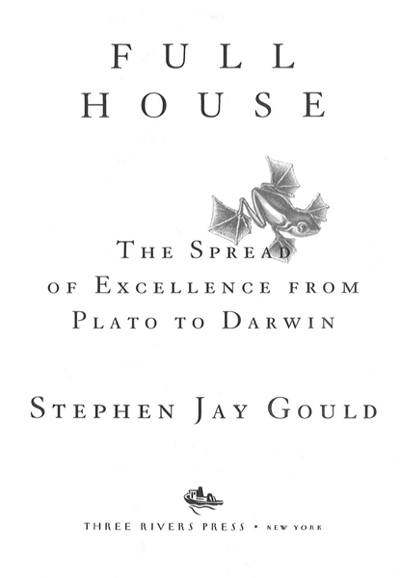
Table of Contents
For Rhonda,
who is the embodiment of excellence

Das Ewig Weibliche
zieht uns hinan
Praise for FULL HOUSE
"Stephen Jay Gould uses a lifetime obsession with baseball, a close call with cancer, and an enormous knowledge of the history of life to build a case that links sport, disease, statistics, and evolution into a seamless narrative and ... he does so brilliantly.... Full House breaks new ground in combining exemplary popular science with a new insight into the nature of evolution.... For the first time in the history of science writing, he succeeds in making statistics interesting."
New York Review of Books
"A marvelously erudite and entertaining tour of evolutions dazzling diversity and richness... an experience ordinarily available only to the lucky few admitted to [Dr. Goulds] Harvard classes."
San Francisco Chronicle
"The details of Mr. Goulds arguments continue to offer characteristic delights."
New York Times Book Review
"Stephen Jay Gould is a superb science teacher, in full command of his subject and possessed of a rhetorical manner so delightfully ebullient its irresistible."
New York Newsday
"From baseball to biology, this book covers a lot of territory. The thesis is engaging and important.... Full House illuminates so many areas and offers such ample evidence that it has the feel of the definitive about it."
Atlanta Journal
"Stephen Jay Gould may be the most readable science writer today, a splendid explainer of things that, in the hands of others, are too often incomprehensible.... This is ingeniousness and, to use Goulds own term, truly superb."
Newark Sunday Star-Ledger
"Insightful ... his ideas are important."
Library Journal
Grateful acknowledgment is made for permission to reprint or adapt the following:
FIGURE 1A
"Ideal Landscape of the Silurian Period," from Louis Figuier, Earth Before the Deluge, 1863.
Neg. no. 2A22970. Copyright Jackie Beckett (photograph taken from book). Courtesy Department
of Library Services, American Museum of Natural History.
FIGURE 1B
"Ideal Scene of the Lias with Ichthyosaurus and Plesiosaurus," from Louis Figuier,
Earth Before the Deluge, 1863. Neg. no. 2A22971. Copyright Jackie Beckett (photograph taken from
book). Courtesy Department of Library Services, American Museum of Natural History.
FIGURE 1C
"Fantastic, Scorpionlike Eurypterids, Some Eight Feet Long, Spent Most of Their Time Half Buried
in Mud," by Charles R. Knight. Courtesy of the National Geographic Society Image Collection.
FIGURE 1D
"Mosasaurus Ruled the Waves When They Rolled Over Western Kansas,"
by Charles R. Knight. Courtesy of the National Geographic Society Image Collection.
FIGURE 1E
"Pterygotus and Eurypterus," by Zdemek Burian, from Prehistoric Animals, edited by Joseph
Augusta. Neg. no. 338586. Copyright 1996 by Jackie Beckett. Courtesy Department of Library
Services, American Museum of Natural History.
FIGURE IF
"Elasmosaurus," by Zdemek Burian, from Prehistoric Animals, edited by Joseph Augusta. Neg.
no. 338585. Copyright 1996 by Jackie Beckett. Courtesy Department of Library Services,
American Museum of Natural History.
FIGURES 2A, 2B
Reprinted with the permission of Simon & Schuster from The Road Less Traveled by M. Scott Peck.
Copyright 1978 by M. Scott Peck.
FIGURE 8
"Genealogy of the Horse," by O. C. Marsh. Originally appeared in American Journal of Science, 1879.
Neg. no. 123823. Courtesy Department of Library Services, American Museum of Natural History.
FIGURE 9
"The Evolution of the Horse," by W. D. Matthew. Appeared in Quarterly Review of Biology,
1926. Neg. no. 37969. Copyright by Irving Dutcher. Courtesy Department of Library Services,
American Museum of Natural History.
FIGURES 10, 11
From "Explosive Speciation at the Base of the Adaptive Radiation of Miocene Grazing Horses,"
by Bruce MacFadden and Richard Hulbert, Jr. Copyright 1988 by Macmillan Magazines Ltd.
From Nature, 336:6198, 1988, 466-68. Reprinted with permission from
Nature, Macmillan Magazines Limited.
FIGURES 14, 19
Adapted from illustrations by Philip Simone in "Entropic Homogeneity Isnt Why No One Hits
.400 Any More," by Stephen Jay Gould. Discover, August 1986, 60-66. Adapted with permission
of Discover.
FIGURE 15
Adapted from an illustration by Cathy Hall in "Losing the Edge: The Extinction of the .400 Hitter."
Vanity Fair, March 1983, 264-78. Adapted with permission of Vanity Fair.
FIGURES 16, 22, 23, 24, 25, 27
Adapted from "Presidential Address," by Stephen Jay Gould. Copyright 1988 by
Stephen Jay Gould. Journal of Paleontology, 62:3, 1988, 320-24. Adapted with permission of
Journal of Paleontology:
FIGURE 17
Adapted from The Bill James Historical Baseball Abstract. Copyright 1986 by Bill James.
New York: Villard Books, 1986. Adapted with permission of the Darhansoff & Verrill Literary
Agency on behalf of the author.
FIGURE 18
Reprinted by permission of Sangit Chatterjee.
FIGURE 26
Adapted from "Causality and Copes Rule: Evidence from the Planktonic Foraminifera,"
by A. J. Arnold, D. C. Kelly, and W. C. Parker. Journal of Paleontology, 69:2, 1995, 204.
Adapted with permission of Journal of Paleontology.
FIGURES 28, 29
Adapted from illustrations by David Starwood, from "The Evolution of Life on the Earth," by
Stephen Jay Gould. Scientific American, October 1994, 86. Copyright 1994 by Scientific American.
All rights reserved.
FIGURE 30
"Modern Stromatolites." Copyright by Franois Gohier.
Reprinted by permission of Photo Researchers, Inc.
FIGURE 31
Adapted from "Universal Phylogenetic Tree in Rooted Form." Copyright 1994 by Carl R. Woese.
Microbiological Reviews, 58, 1994, 1-9. Adapted with permission of the author.
FIGURE 32
Adapted from "Evolutionary Change in the Morphological Complexity of the
Mammalian Vertebral Column." Copyright 1993 by Donald W. McShea. Evolution, 47, 1993,
730-40. Adapted with permission of the author.
FIGURES 33, 34
Adapted from "Mechanisms of Large-Scale Evolutionary Trends." Copyright 1994 by Donald W.
McShea. Evolution, 48, 1994, 1747-63. Adapted with permission of the author.
FIGURE 35
Reprinted by permission of George Boyajian.
FIGURE 36
Adapted from "Taxonomic Longetivity of Fossil Ammonoid," from an article by George Boyajian, in
Geology, 20, 1992, 983-986. Adapted by permission of Geology.
A Modest Proposal
In an old literary theme, from Jesus parable of the prodigal son to Tennessee Williamss Cat on a Hot Tin Roof, our most beloved child is often the most problematic and misunderstood among our offspring. I worry for Full House, my adored and wayward boy. I have nurtured this short book for fifteen years through three distinctly different roots (and routes): (1) an insight about the nature of evolutionary trends that popped into my head one day, revised my personal thinking about the history of life, and emerged in technical form as a presidential address for the Paleontological Society in 1988; (2) a statistical eureka that brought me much hope and comfort during a life-threatening illness (see chapter 4); and (3) an explanation that, once conceptualized, struck me as self-evident and necessarily correct, but also diametrically opposed to all traditional accounts, for a major puzzle of American popular culturethe disappearance of 0.400 hitting in baseball.
Next page


